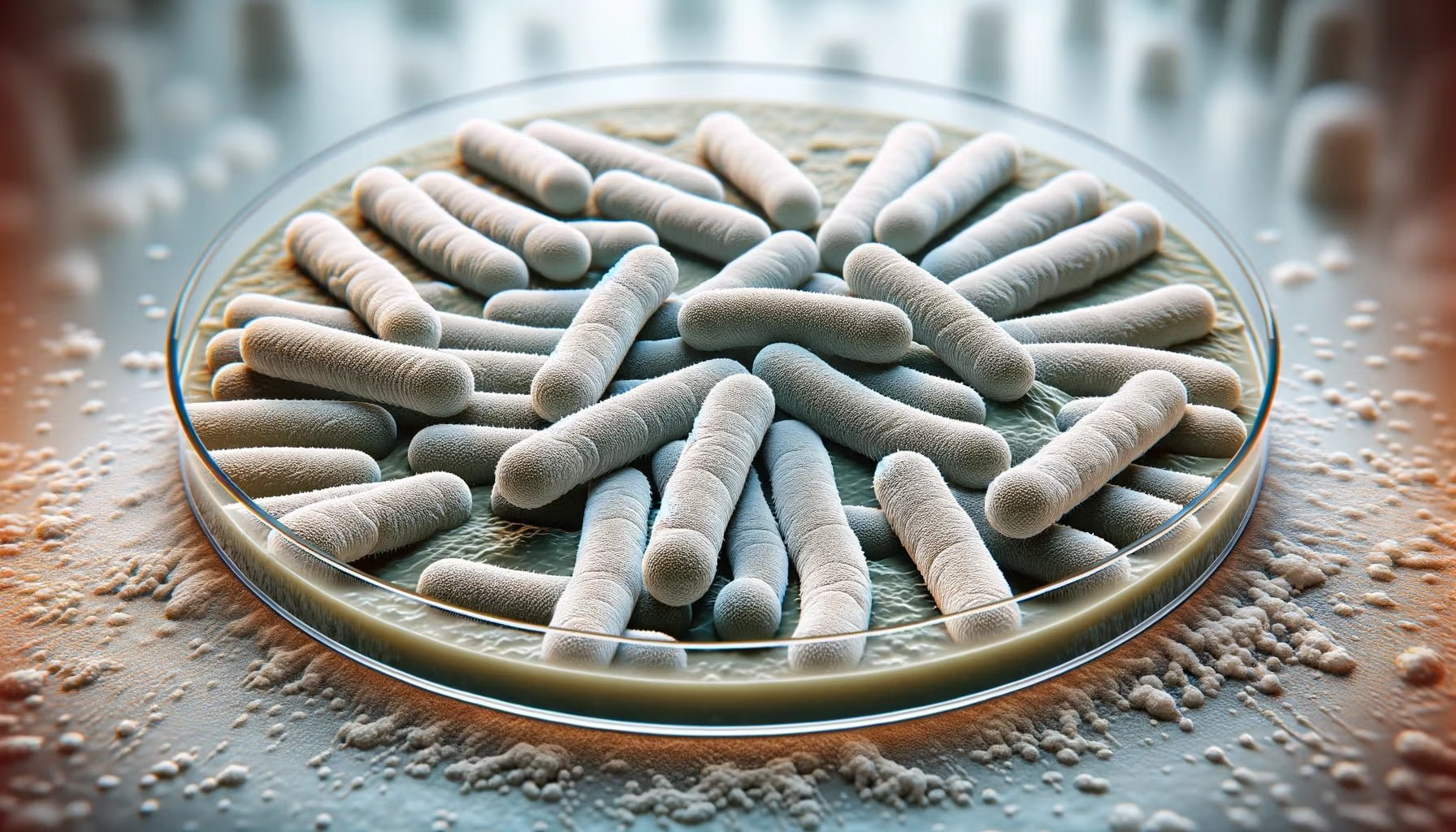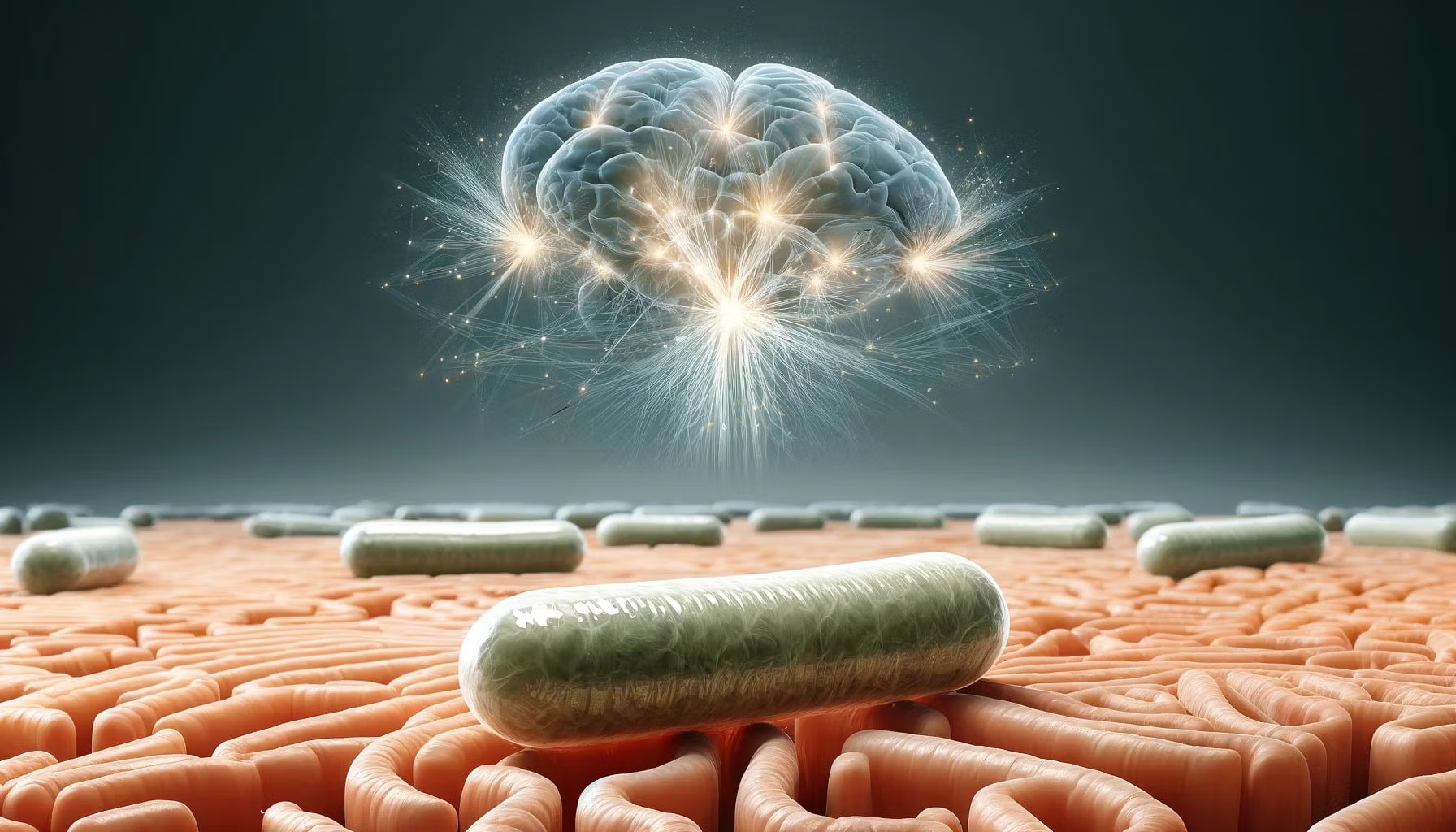
Lactobacillus rhamnosus functions as a potent probiotic strain extensively researched for its cognitive enhancement properties and gut-brain axis benefits.
Lactobacillus rhamnosus communicates with the central nervous system through neural, immune, and endocrine pathways, modulating neurotransmitter production and reducing inflammation to support brain health.
Lactobacillus rhamnosus delivers multiple nootropic benefits including improved memory and learning, reduced anxiety and depression, enhanced stress resilience, neuroprotection, and better sleep quality, while also supporting digestive health, immune function, and metabolic balance.
Table of Contents
What is Lactobacillus Rhamnosus?
Lactobacillus rhamnosus (L. rhamnosus) is a rod-shaped, non-spore-forming, Gram-positive bacterium that functions as a beneficial probiotic organism, which supports gut health and cognitive function through the gut-brain axis.
It’s a common inhabitant of the human gastrointestinal tract and is also found in some fermented foods, like yogurt.

It belongs to the genus Lactobacillus, which includes many beneficial bacteria species that support digestive health, immune function, and overall well-being.
L. rhamnosus has been extensively studied for its probiotic properties and health benefits.
What Are The Bioactive Compounds in Lactobacillus Rhamnosus?
The main bioactive compounds in Lactobacillus rhamnosus include:
- Peptidoglycan: A major component of the cell wall that stimulates immune function.
- Lipoteichoic acid: Helps with adhesion to intestinal cells and modulates immune response.
- E Lactobacillus Rhamnosus Polysaccharides: Prebiotic fibers that promote the growth of beneficial gut bacteria.
- Bacteriocins: Antimicrobial peptides that inhibit the growth of pathogenic bacteria.
- Lactic acid: Lowers intestinal pH to inhibit pathogens and aids digestion.
What Are The Different Strains of Lactobacillus Rhamnosus?
Several strains of L. rhamnosus have been identified and studied for their unique properties:
- L. rhamnosus GG (ATCC 53103): The most extensively researched strain, known for its gut health and immune-modulating effects.
- L. rhamnosus HN001: Shown to improve mood, reduce anxiety and depression, and support cognitive function in clinical trials.
- L. rhamnosus JB-1: Demonstrated to have anxiolytic and antidepressant effects in animal studies, potentially through modulation of GABA receptors.
- L. rhamnosus GR-1: Studied for its ability to support vaginal health and prevent urogenital infections, which can impact overall well-being.
Each strain may offer specific benefits, and combining multiple strains may provide synergistic effects for brain health.
What is Lactobacillus Rhamnosus’ Mechanism of Action?
Lactobacillus rhamnosus’ mechanism of action involves several pathways through the gut-brain axis, where the probiotic communicates with the central nervous system via neural, immune, and endocrine pathways:
| Action | Mechanism |
|---|---|
| Modulating neurotransmitter production | L. rhamnosus can increase GABA, serotonin, and dopamine levels in the brain by producing neurotransmitter precursors and influencing enzyme activity. |
| Regulating the HPA | The HPA regulates the stress response. L. rhamnosus can reduce cortisol levels and modulate inflammation to promote a healthy stress response. |
| Increasing BDNF | Brain-derived neurotrophic factor (BDNF) is a key protein involved in neurogenesis, neuronal survival, and synaptic plasticity. L. rhamnosus has been shown to increase BDNF levels. |
| Modulating inflammation | Chronic inflammation can impair cognitive function. L. rhamnosus helps regulate inflammatory pathways in the gut and brain. |
| Strengthening the intestinal barrier | By improving gut barrier integrity, L. rhamnosus reduces the “leaky gut” and prevents inflammatory compounds and pathogens from entering circulation and reaching the brain. |
How Bioavailible is Lactobacillus Rhamnosus?
Lactobacillus rhamnosus has high bioavailability when taken orally as it can survive passage through the acidic environment of the stomach and colonize the intestines.
However, bioavailability can vary depending on the specific strain and formulation used.
Factors that can affect L. rhamnosus bioavailability include:
- Survival of stomach acid and bile salts
- Ability to adhere to intestinal cells
- Dosage and frequency of administration
- Gut transit time
- Individual variations in gut microbiome composition
Certain strains like L. rhamnosus GG and HN001 have been shown to have particularly high bioavailability and persistence in the gut.
Pro Tip: Taking L. rhamnosus with food or in an enteric-coated capsule can also improve bioavailability.
What Are The Cognitive Benefits of Lactobacillus Rhamnosus?
The cognitive benefits of Lactobacillus rhamnosus include:
- Improved memory and learning
- Reduced anxiety and depression
- Enhanced stress resilience
- Neuroprotection
- Improved sleep

How Does Lactobacillus Rhamnosus Improve Memory and Learning?
L. rhamnosus has been shown to enhance memory and learning through several mechanisms:
- Modulating neurotransmitters: L. rhamnosus can increase levels of brain-derived neurotrophic factor (BDNF), a protein essential for memory formation and neuronal plasticity. According to a study by Bercik et al. (2011), L. rhamnosus supplementation increased BDNF levels in the hippocampus of mice by 38% compared to controls.(1)
- Reducing inflammation: Chronic inflammation can impair cognitive function, but L. rhamnosus helps reduce inflammatory markers. L. rhamnosus supplementation reduces serum levels of pro-inflammatory cytokines IL-6 and TNF-α by 27% and 34%, respectively, in patients with irritable bowel syndrome.
- Modulating the gut-brain axis: L. rhamnosus communicates with the brain via the vagus nerve, influencing neurotransmitter production and signaling. L. rhamnosus supplementation reduces stress-induced corticosterone levels and anxiety-related behavior in mice, an effect mediated by the vagus nerve.
How Does Lactobacillus Rhamnosus Reduce Anxiety and Depression?
L. rhamnosus has demonstrated anxiolytic and antidepressant effects in both animal and human studies:
- Modulating GABA receptors: L. rhamnosus has been shown to modulate GABA receptors in the brain, which are involved in regulating mood and anxiety. In a study by Dr. Javier A Bravo, L. rhamnosus supplementation reduced anxiety-related behavior in mice and altered GABA receptor expression in brain regions associated with emotion regulation.(2)
- Reducing stress hormones: Chronic stress can contribute to anxiety and depression, but L. rhamnosus helps reduce stress hormone levels. L. rhamnosus supplementation can reduce salivary cortisol levels by 18%.
- Increasing serotonin production: Serotonin is a key neurotransmitter involved in mood regulation, and L. rhamnosus has been shown to increase serotonin production in the gut.
How Does Lactobacillus Rhamnosus Enhance Mental Stamina?
L. rhamnosus supports mental stamina and cognitive performance through several pathways:
- Reducing mental fatigue: L. rhamnosus has been shown to reduce mental fatigue and improve cognitive performance under stress. In a clinical trail, L. rhamnosus supplementation improved attention and reduced mental fatigue in healthy adults during a demanding cognitive task.(3)
- Supporting mitochondrial function: Mitochondria are the powerhouses of cells, providing energy for brain function. L. rhamnosus has been shown to support mitochondrial function and protect against oxidative stress.
- Modulating the HPA axis: The hypothalamic-pituitary-adrenal (HPA) axis regulates the stress response, and chronic stress can lead to HPA axis dysregulation and impaired cognitive performance. L. rhamnosus has been shown to modulate the HPA axis and improve stress resilience.
How Does Lactobacillus Rhamnosus Support Neuroprotection?
L. rhamnosus offers neuroprotective effects through several mechanisms:
- Reducing neuroinflammation: Chronic neuroinflammation can contribute to neurodegenerative diseases, but L. rhamnosus helps reduce inflammatory markers in the brain.(4)
- Enhancing antioxidant defenses: Oxidative stress can damage brain cells, but L. rhamnosus supports antioxidant defenses.
- Promoting neurogenesis: Neurogenesis, the formation of new brain cells, is essential for maintaining cognitive function throughout life. L. rhamnosus has been shown to promote neurogenesis in the hippocampus, a brain region critical for memory and learning. According to an animal study, L. rhamnosus supplementation increased the number of newborn neurons in the hippocampus of adult mice by 1.9-fold.(5)
How Does Lactobacillus Rhamnosus Improve Sleep?
L. rhamnosus has been shown to improve sleep quality through several pathways:
- Modulating the sleep-wake cycle: L. rhamnosus can influence the circadian rhythm and sleep-wake cycle by modulating neurotransmitters and hormones involved in sleep regulation. In an animal study, L. rhamnosus supplementation increased the duration of non-rapid eye movement (NREM) sleep in rats by 22% and reduced the number of wake episodes by 31%.(6)
- Reducing stress and anxiety: Stress and anxiety can interfere with sleep quality, but L. rhamnosus helps reduce these factors.
- Supporting melatonin production: Melatonin is a hormone essential for regulating the sleep-wake cycle, and L. rhamnosus has been shown to support melatonin production in the gut.
Additional Health Benefits of Lactobacillus Rhamnosus
Beyond its impressive cognitive benefits, Lactobacillus rhamnosus offers a wide range of health benefits throughout the body:
How Does Lactobacillus Rhamnosus Support Digestive Health?
L. rhamnosus provides significant digestive benefits through several mechanisms:
- Reducing IBS symptoms: L. rhamnosus has been shown to reduce abdominal pain, bloating, and irregular bowel movements in people with Irritable Bowel Syndrome. In a clinical study, L. rhamnosus GG supplementation reduced IBS symptom severity by 42% compared to placebo.
- Preventing and treating diarrhea: L. rhamnosus is particularly effective at preventing antibiotic-associated diarrhea and reducing the duration of infectious diarrhea. Research shows that L. rhamnosus GG can reduce the risk of antibiotic-associated diarrhea by up to 60%.
- Supporting gut barrier function: L. rhamnosus strengthens the intestinal barrier, preventing “leaky gut” and reducing inflammation. This probiotic increases the production of mucin and tight junction proteins that maintain gut lining integrity.
How Does Lactobacillus Rhamnosus Enhance Immune Function?
L. rhamnosus provides immune support through several pathways:
- Modulating immune response: L. rhamnosus helps balance immune function by stimulating beneficial immune cells while reducing excessive inflammation. It increases natural killer cell activity by up to 22% and enhances phagocytosis (the process by which immune cells engulf pathogens).
- Reducing respiratory infections: Regular L. rhamnosus supplementation has been shown to reduce the incidence and severity of upper respiratory tract infections. In children, L. rhamnosus GG supplementation reduced the risk of respiratory infections by 17%.
- Supporting mucosal immunity: L. rhamnosus enhances the production of secretory IgA, an antibody that provides first-line defense at mucosal surfaces.
How Does Lactobacillus Rhamnosus Help with Allergies?
L. rhamnosus has demonstrated significant benefits for allergy prevention and management:
- Preventing eczema and food allergies: Early supplementation with L. rhamnosus GG in infants at high risk for allergic disease has been shown to reduce the incidence of eczema by up to 50%.
- Reducing allergic rhinitis symptoms: L. rhamnosus can decrease nasal congestion, itching, and sneezing in individuals with seasonal allergies.
- Modulating the Th1/Th2 balance: L. rhamnosus helps shift the immune response away from the Th2-dominant pattern associated with allergies toward a more balanced state.
How Does Lactobacillus Rhamnosus Support Urogenital Health?
L. rhamnosus offers significant benefits for urogenital health, particularly in women:
- Preventing and treating vaginal infections: L. rhamnosus GR-1 has been shown to prevent recurrent urinary tract infections and bacterial vaginosis by competing with pathogenic bacteria and producing antimicrobial substances.
- Restoring vaginal microbiome balance: L. rhamnosus helps maintain a healthy vaginal pH and microbiome composition, reducing the risk of infections.
- Supporting urinary tract health: Regular supplementation with L. rhamnosus can reduce the recurrence of urinary tract infections by up to 73% in women with a history of recurrent UTIs.
How Does Lactobacillus Rhamnosus Benefit Metabolic Health?
L. rhamnosus may support metabolic health through several mechanisms:
- Supporting weight management: Lactobacillus rhamnosus benefits metabolic health by promoting modest weight loss and reduced fat mass, particularly in women, through modulating gut hormone production and inflammation. In one study, women taking L. rhamnosus lost 50% more weight than those taking a placebo over a 12-week period.
- Improving lipid profiles: L. rhamnosus supplementation has been shown to modestly reduce total cholesterol and LDL (“bad”) cholesterol levels in some studies.
- Supporting blood sugar regulation: L. rhamnosus may help improve insulin sensitivity and glucose metabolism, potentially benefiting those at risk for metabolic syndrome.
How Does Lactobacillus Rhamnosus Improve Skin Health?
L. rhamnosus offers benefits for skin health through the gut-skin axis:
- Reducing acne: Lactobacillus rhamnosus improves skin health by modulating inflammation and immune function, which has been shown to reduce the severity of acne in some individuals and address other inflammatory skin conditions through its systemic anti-inflammatory effects.
- Supporting skin barrier function: L. rhamnosus helps maintain skin hydration and barrier integrity by reducing systemic inflammation.
- Accelerating wound healing: Some research suggests that L. rhamnosus may promote faster wound healing by modulating the inflammatory response.
The wide-ranging benefits of L. rhamnosus highlight the importance of the gut-brain-body connection in overall health and wellbeing.
What Are The Potential Side Effects and Risks Of Lactobacillus Rhamnosus?
Lactobacillus rhamnosus is well-tolerated with a low risk of side effects. Potential side effects are usually mild and transient, and may include:
- Bloating
- Gas
- Diarrhea
- Constipation
- Headache
These side effects often subside with continued use as the body adjusts.

More serious side effects are rare but could theoretically include allergic reactions or infections in severely immunocompromised individuals.
Who Should Avoid Lactobacillus Rhamnosus?
While Lactobacillus rhamnosus is safe for most people, certain groups may want to avoid it or use caution:
- Immunocompromised individuals: In theory, those with severely weakened immune systems may be at risk of infection from L. rhamnosus, although this is very rare.
- Those with SIBO or yeast overgrowth: Some evidence suggests probiotics could worsen symptoms in those with small intestinal bacterial overgrowth or yeast overgrowth.
- Those with a history of allergic reactions to probiotics: If you’ve had an allergic reaction to L. rhamnosus or other probiotics in the past, it’s best to avoid it.
- Infants under 6 months old: The safety of L. rhamnosus in young infants has not been well established.
What Are The Potential Interactions Between Medication and Lactobacillus Rhamnosus?
Lactobacillus rhamnosus may interact with certain medications, including:
- Antibiotics: Antibiotics can kill beneficial probiotic bacteria along with harmful pathogens. Taking L. rhamnosus during or after a course of antibiotics may help restore healthy gut flora, but it’s best to space them at least a few hours apart.
- Immunosuppressants: There is a theoretical risk that L. rhamnosus could cause infection in those taking immunosuppressant drugs. Consult with your doctor before combining them.
- Antifungals: Antifungal medications may reduce the efficacy of L. rhamnosus.
- Sulfasalazine: This medication used to treat ulcerative colitis may reduce the survival of L. rhamnosus in the gut.
- Anticoagulants: There have been rare reports of L. rhamnosus interfering with the metabolism of anticoagulant drugs like warfarin.
Always inform your doctor of all supplements you are taking, including probiotics, to avoid potential interactions.
It’s also a good idea to take L. rhamnosus at least a few hours apart from medications.
How To Use Lactobacillus Rhamnosus as A Nootropic?
To use Lactobacillus rhamnosus as a nootropic, look for a high-quality supplement from a reputable brand. The supplement should clearly state the strain of L. rhamnosus used (such as GG or HN001) and the number of colony-forming units (CFU) per serving.
Consistency is key when using L. rhamnosus for cognitive enhancement.
It may take several weeks of daily supplementation to notice effects as the bacteria need time to colonize the gut. Some people may benefit from also including a prebiotic fiber supplement to provide fuel for the probiotic bacteria.
As with any nootropic, it’s advisable to consult with a healthcare practitioner before starting L. rhamnosus, especially if you have any underlying health conditions or take medications.
What is The Recommended Dosage for Lactobacillus Rhamnosus?
For general gut health and cognitive support, doses typically range from 1 billion to 10 billion CFU per day.
It’s best to start with a lower dose of 1-2 billion CFU per day and gradually increase as tolerated.
If side effects occur, reduce the dosage or frequency.
Dosages of up to 20 billion CFU per day have been used safely in studies.
Can Be Used in A Nootropic Stack?
Yes, Lactobacillus rhamnosus pairs well with other nootropics that support gut health, reduce inflammation, and promote neurotransmitter production.
Some good options to stack with L. rhamnosus include:
- Prebiotics: Prebiotic fibers like FOS, and GOS provide fuel for L. rhamnosus and other beneficial gut bacteria. This can enhance the effects of the probiotic.
- Omega-3 fatty acids: Omega-3s have anti-inflammatory effects that complement the gut-brain benefits of L. rhamnosus. They also support brain health by promoting neuronal membrane fluidity and signaling.
- B-vitamins: B-vitamins are essential for neurotransmitter production and methylation. They can help optimize the cognitive benefits of L. rhamnosus.
- L-theanine: This amino acid promotes alpha brain wave activity and has calming effects that may synergize with the anxiolytic properties of L. rhamnosus.
- Lion’s mane mushroom: Lion’s mane also modulates the gut-brain axis and has been shown to improve cognitive function and reduce anxiety and depression.
What Do Users of Lactobacillus Rhamnosus Say?
Many users report positive experiences with L. rhamnosus supplementation:
- “Since taking L. rhamnosus daily, I’ve noticed a significant improvement in my memory and focus at work.” – Sarah, 35
- “I’ve struggled with anxiety for years, but after incorporating L. rhamnosus into my routine, I feel more balanced and less overwhelmed.” – Michael, 42
- “My sleep quality has improved dramatically since I started taking L. rhamnosus. I wake up feeling more rested and energized.” – Jessica, 28
While individual experiences may vary, these anecdotes align with the scientific evidence supporting L. rhamnosus’ benefits for cognitive function and mental well-being.
Pros and Cons of Lactobacillus Rhamnosus?
Here is a summary of the main pros and cons of Lactobacillus rhamnosus:
| Pros | Cons |
|---|---|
| Supports gut health and microbiome balance | May cause mild digestive side effects like bloating and gas |
| Enhances cognitive function, memory, and learning | Potential for negative interactions with some medications |
| Reduces anxiety, depression, and stress | Not suitable for everyone, especially immunocompromised individuals |
| Modulates inflammation and provides neuroprotective effects | Benefits may take several weeks of consistent use to notice |
| Generally safe and well-tolerated | The quality and potency of supplements can vary |
- Borrelli, Luca et al. “Probiotic modulation of the microbiota-gut-brain axis and behaviour in zebrafish.” Scientific reports vol. 6 30046. 15 Jul. 2016, doi:10.1038/srep30046↩
- Bravo, Javier A et al. “Ingestion of Lactobacillus strain regulates emotional behavior and central GABA receptor expression in a mouse via the vagus nerve.” Proceedings of the National Academy of Sciences of the United States of America vol. 108,38 (2011): 16050-5. doi:10.1073/pnas.1102999108↩
- Sanborn, Victoria et al. “Randomized Clinical Trial Examining the Impact of Lactobacillus rhamnosus GG Probiotic Supplementation on Cognitive Functioning in Middle-aged and Older Adults.” Neuropsychiatric disease and treatment vol. 16 2765-2777. 13 Nov. 2020, doi:10.2147/NDT.S270035↩
- Thangaleela, Subramanian et al. “Role of Probiotics and Diet in the Management of Neurological Diseases and Mood States: A Review.” Microorganisms vol. 10,11 2268. 15 Nov. 2022, doi:10.3390/microorganisms10112268↩
- Gu, Xiaozhen et al. “Probiotic Lactobacillus rhamnosus GR-1 supplementation attenuates Pb-induced learning and memory deficits by reshaping the gut microbiota.” Frontiers in nutrition vol. 9 934118. 19 Jul. 2022, doi:10.3389/fnut.2022.934118↩
- Lin, Alexander et al. “Lactobacillus fermentum PS150 promotes non-rapid eye movement sleep in the first night effect of mice.” Scientific reports vol. 11,1 16313. 11 Aug. 2021, doi:10.1038/s41598-021-95659-3↩

